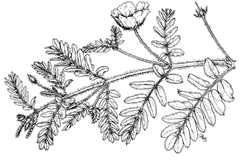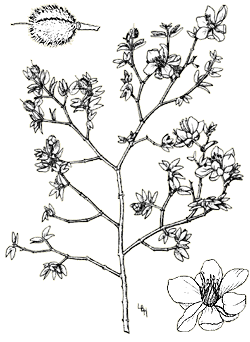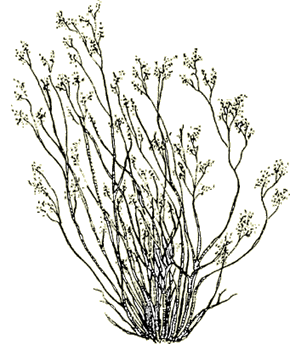Zygophyllaceae (caltrop family)
The caltrop family is a small one of about 250 species. The best-known (and most-hated) species is goat-head or puncture vine (Tribulus terrestris), a weed introduced from Europe. Lignum vitae (Guaiacum spp.) is perhaps the hardest wood in the world. Though there are only a few caltrop species in our region, one of them is among the most abundant and widespread desert plants and another is a showy summer wildflower.
Kallstroemia grandiflora
English names: Summer poppy,
Arizona poppy, orange caltrop
Spanish names: vaivurín, mal de ojo (sore eye)
Description
This is a summer annual that grows nearly prostrate to 3 feet (0.9 m) across with sparse divided foliage. Flowers are over an inch across (about 3 cm) with 5 petals. In early morning they open a bright orange with darker striations, then fade to pale orange with the afternoon heat. In the southern part of the range, pink-flowered plants appear as well.
 |
Range
Summer poppy grows from northern Arizona to Texas and south to Colima, Mexico; it is also found in southern Baja California. It occurs in desert and tropical habitats but is most abundant in desert grassland, where it creates mass displays of color reminiscent of the desert blooms of spring annuals. In the desert it occurs as widely scattered individuals or occasional small patches.
Notes
Summer poppy seeds have a long dormancy. They will usually not germinate until they are several years old, and presumably remain viable in the soil for many decades.
Kallstroemia parviflora and K. californica look vegetatively similar but have much smaller orange flowers. Seedling summer poppies may also be confused with the related puncture vine or goat-head (Tribulus terrestris). Puncture vine has tiny yellow flowers and bur-like seeds with strong, sharp spines.
The seeds of puncture vine, a European weed, are well adapted to dispersal by rubber tires, and the plant now grows along the runways of every temperate airport in the world (not to mention most bicycle paths). Once a serious pest in North America, its numbers have been effectively reduced by introducing a weevil that feeds specifically on puncture vine seeds. There is disturbing evidence, however, that the beetle is now attacking summer poppy. Biological pest control (integrated pest management) is much less damaging to the environment than the use of broad-spectrum pesticides, but it too can go awry and must be employed very carefully.
Larrea tridentata [L. divaricata]
English names: creosote bush,
greasewood, covillea
Spanish names: gobernadora
(governor), hediondilla
(little stinker), guamis
Alphabetically creosote bush comes at the very end of our list of Sonoran Desert plants. If the list were arranged in order of importance—either ecological or cultural—this species would be near the top. Most visitors and Anglo residents notice it only because of its abundance, but those who live intimately with the desert have a very different outlook.
 |
Description
This is an evergreen shrub, 3 to 6 feet (0.9 to 1.8 m) tall, sometimes taller. Many stems rise at an angle from the ground. The small, dark green, resinous leaves are borne mostly at the tips of twigs and the rest of the branches are bare. Small yellow flowers appear throughout the year following rains, most abundantly in spring. The fruit is a small, woolly ball which separates into 5 segments when mature.
Range
Creosote bush is the most common and widespread shrub in 3 of the 4 North American deserts. Cold winters exclude it from the Great Basin Desert. It also occurs in Argentina as the same or closely related species L. divaricata.
Notes
The foliage emits a strong aroma, especially after rains. This fragrance is identified as “the smell of rain” wherever creosote bush grows. Though pungent, it is not repulsive like the wood preservative called creosote oil, a petroleum product unrelated to the creosote bush.
This is the most drought-tolerant perennial plant in North America. Traveling west from Tucson to the mouth of the Colorado River the rainfall decreases from 12 inches (305 mm) to 3 inches (76 mm). Along this gradient the number of perennial plant species steadily decreases from more than 300 to fewer than 12. Along the lower river and the head of the Gulf of California there are valleys with only creosote bush and white bursage on the flats between drainages, and in some places even the bursage drops out, leaving pure stands of creosote. It can live for at least 2 years with no rain, losing its leaves and even shedding branches to reserve its last water and nutrients for the crown.
 |
Although creosote bush roots have been shown to inhibit the growth of bursage roots and the roots of other creosote bushes in their vicinity, the shrub is an important nurse plant. It accumulates enriched soil beneath it and its canopy casts a little shade under which many plants thrive. Most of these are annual species so they are present only in wet years. Creosote bush also commonly shelters cacti such as Echinocereus, Mammillaria, and Peniocereus. Creosote roots also secrete a germination inhibitor that affects its own seeds only. The average distance between creosote plants depends upon the amount of rainfall and soil moisture-holding capacity for the given area.
Jackrabbits are almost the only mammal that eats creosote bush leaves, and only during droughts when little else is available. The soil beneath these shrubs is a favorite place for numerous rodents to dig their burrows, which are in turn used as shelter by even more species of reptiles and invertebrates. More than 60 species of insects are associated with this plant, including 22 species of bees that feed only on its flowers. Many are specific to it, such as the creosote katydid (Insara covillei) and creosote grasshopper (Bootettix argentatus), which are so camouflaged that they are very difficult to find. Lac insects (Tachardiella larreae, a scale insect) can occasionally be found on its stems. Desert peoples used its sticky secretions as a multipurpose sealant and glue. Ball-shaped leafy galls are common on stems. They are produced by the creosote gall midge (Asphondylia); larvae of these small flies live in the protective mass of tissue. The Seri smoked the galls like tobacco.
Creosote bush is among the longest-lived plants. Though each stem lives only a couple of centuries, new ones are continually produced from the outer edge of the root crown. As the dead stems in the center decay, an open ring of stems forms. With passing centuries the ring very slowly expands and breaks into separate bushes, with outliers all of one clone, because they descended from a single original seed. One such ring in the Mohave Desert in California is 26 feet (7.8 m) in diameter and is several thousand years old. Based on current growth rates its age could exceed 11,000 years, but the climate has not always been as arid as today and the plants probably grew somewhat faster in earlier millennia.
Creosote bush is very important to native peoples. The O’odham say it was the first plant created. It is the single most widely-used and frequently-employed medicinal herb in the Sonoran Desert. One of its medicinal names is chaparral tea, though it does not grow in chaparral. The Food and Drug Administration has considered banning its sale based on a couple of deaths attributed to drinking it. But innumerable native peoples and some knowledgeable ethnobotanists drink large quantities of it for a wide variety of ailments with no detectable ill effect (other than gagging from its awful taste). Its antioxidant properties were used in foods and paints through the 1950s and are now being evaluated as anti-cancer agents.
This plant is known as “greasewood” among the O’odham and many ranchers, but to most other people greasewood is Sarcobatus, a Mohave and Great Basin shrub. This is another example of the problem of so-called common names. The Spanish name gobernadora is a political commentary. This fairly new name was invented in northern Mexico and meant to be associated with the already established name of hediondilla (“little stinker”).
Creosote bush originated in South America where there are 5 species of Larrea. It is a mystery how it got to North America; today there is no suitable habitat in the intervening thousands of miles. It arrived here long enough ago to have evolved different chromosome races. In the Chihuahuan Desert the plants have the normal diploid chromosome number (2 of each chromosome, 26 in this case), as do the ones in Argentina. The Sonoran Desert plants are tetraploid, (having 4 sets of chromosomes) and those in the Mohave Desert are hexaploid (6 sets). Plants near their ecological limits often have greater chromosome numbers; the extra genetic material seems to confer more adaptability. In the case of creosote, the limiting factor may be cold temperatures; the Mohave is the coldest of these 3 deserts and its creosotes have the most chromosomes.










